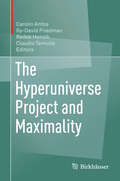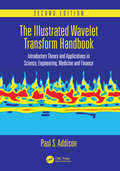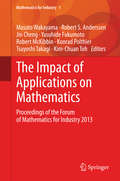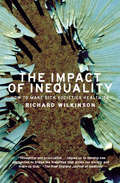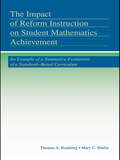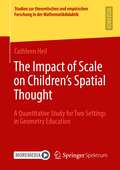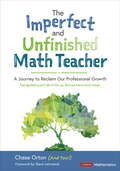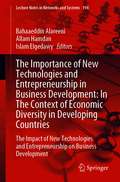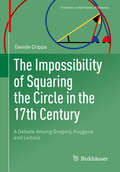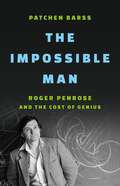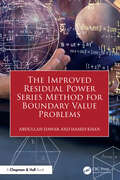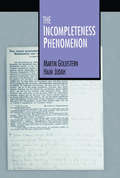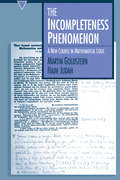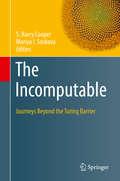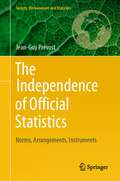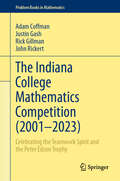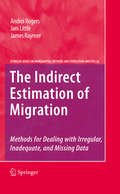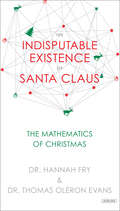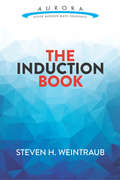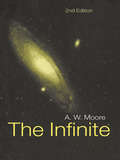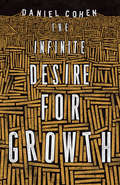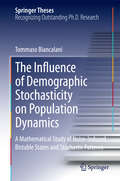- Table View
- List View
The Hyperuniverse Project and Maximality
by Carolin Antos Sy-David Friedman Radek Honzik Claudio TernulloThis collection documents the work of the Hyperuniverse Project which is a new approach to set-theoretic truth based on justifiable principles and which leads to the resolution of many questions independent from ZFC. The contributions give an overview of the program, illustrate its mathematical content and implications, and also discuss its philosophical assumptions. It will thus be of wide appeal among mathematicians and philosophers with an interest in the foundations of set theory. The Hyperuniverse Project was supported by the John Templeton Foundation from January 2013 until September 2015
The Icky Bug Counting Book (Jerry Pallotta's Counting Books)
by Jerry PallottaLearn to count in this &“icky&” introduction to bugs and numbers. For most children, insects and the small world they inhabit is endlessly creepy, crawly, and fascinating. Best-selling author Jerry Pallotta delivers a fun first concepts book that uncovers the wild world of bugs and insects. From the Zebra Swallowtail Butterfly to Yellowjacket Flies, readers will learn intriguing facts while practicing their numbers. Pallotta&’s signature witty yet scientific text paired with Masiello&’s vivid and detailed illustrations makes this exploration of all things creepy-crawly one that will keep readers engaged and curious as they learn about the natural world of bugs.
The Illustrated Wavelet Transform Handbook: Introductory Theory and Applications in Science, Engineering, Medicine and Finance, Second Edition
by Paul S. AddisonThis second edition of The Illustrated Wavelet Transform Handbook: Introductory Theory and Applications in Science, Engineering, Medicine and Finance has been fully updated and revised to reflect recent developments in the theory and practical applications of wavelet transform methods. The book is designed specifically for the applied reader in science, engineering, medicine and finance. Newcomers to the subject will find an accessible and clear account of the theory of continuous and discrete wavelet transforms, while readers already acquainted with wavelets can use the book to broaden their perspective. One of the many strengths of the book is its use of several hundred illustrations, some in colour, to convey key concepts and their varied practical uses. Chapters exploring these practical applications highlight both the similarities and differences in wavelet transform methods across different disciplines and also provide a comprehensive list of over 1000 references that will serve as a valuable resource for further study. Paul Addison is a Technical Fellow with Medtronic, a global medical technology company. Previously, he was co-founder and CEO of start-up company, CardioDigital Ltd (and later co-founded its US subsidiary, CardioDigital Inc) - a company concerned with the development of novel wavelet-based methods for biosignal analysis. He has a master’s degree in engineering and a PhD in fluid mechanics, both from the University of Glasgow, Scotland (founded 1451). His former academic life as a tenured professor of fluids engineering included the output of a large number of technical papers, covering many aspects of engineering and bioengineering, and two textbooks: Fractals and Chaos: An Illustrated Course and the first edition of The Illustrated Wavelet Transform Handbook. At the time of publication, the author has over 100 issued US patents concerning a wide range of medical device technologies, many of these concerning the wavelet transform analysis of biosignals. He is both a Chartered Engineer and Chartered Physicist.
The Impact of Applications on Mathematics
by Yasuhide Fukumoto Konrad Polthier Tsuyoshi Takagi Robert S. Anderssen Masato Wakayama Jin Cheng Robert Mckibbin Kim-Chuan TohThis book is a collection of papers presented at the Forum "The Impact of Applications on Mathematics" in October 2013. It describes an appropriate framework in which to highlight how real-world problems, over the centuries and today, have influenced and are influencing the development of mathematics and thereby, how mathematics is reshaped, in order to advance mathematics and its application. The contents of this book address productive and successful interaction between industry and mathematicians, as well as the cross-fertilization and collaboration that result when mathematics is involved with the advancement of science and technology.
The Impact of Inequality: How to Make Sick Societies Healthier
by Richard WilkinsonA &“powerful and provocative&” inquiry into the relationship between societies&’ inequality and their citizens&’ health, happiness and well-being (Lisa Berkman, Harvard School of Public Health). Comparing the United States with other market democracies, and one American state with another, this book presents irrefutable evidence that inequality is a driver of poor health, social conflict, and violence. Pioneering social scientist Richard Wilkinson addresses the growing feeling—so common in the United States—that modern societies, despite their material success, are social failures. The Impact of Inequality explains why inequality has such devastating effects on the quality and length of our lives. Wilkinson shows that inequality leads to stress, which in turn creates sickness on the individual and mass level. As a consequence, society suffers widespread unhappiness and high levels of violence, depression, and mistrust across the social spectrum. With persuasive evidence and fascinating analysis, the diagnosis is clear: Social and political equality are essential to improving life for everyone. Wilkinson argues that even small reductions in inequality can make an important difference—for, as this book explains, social relations are always built on material foundations. &“This new book, a wonderful work of synthesis, brings insight into how conditions of society impact on people&’s daily lives. . . . It is a stimulating and exciting book.&” —Sir Michael Marmot, author of The Status Syndrome
The Impact of Reform Instruction on Student Mathematics Achievement: An Example of a Summative Evaluation of a Standards-Based Curriculum (Studies in Mathematical Thinking and Learning Series)
by Thomas A. Romberg Mary C. ShaferSummarizing data derived from a four-year combined longitudinal/ cross-sectional comparative study of the implementation of one standards-based middle school curriculum program, Mathematics in Context, this book demonstrates the challenges of conducting comparative longitudinal research in the reality of school life. The study was designed to answer three questions: What is the impact on student performance of the Mathematics in Context instructional approach, which differs from most conventional mathematics texts in both content and expected pedagogy? How is this impact different from that of traditional instruction on student performance? What variables associated with classroom instruction account for variation in student performance? The researchers examined a range of variables that affected data collection. These variations highlight the need to study the effects of the culture in which student learning is situated when analyzing the impact of standards-based curricula on student achievement. This book is directed to educational researchers interested in curriculum implementation, mathematics educators interested in the effects of using reform curriculum materials in classrooms, evaluators and research methodologists interested in structural modeling and scaling of instructional variables, and educational policy makers concerned about reform efforts.
The Impact of Scale on Children’s Spatial Thought: A Quantitative Study for Two Settings in Geometry Education (Studien zur theoretischen und empirischen Forschung in der Mathematikdidaktik)
by Cathleen HeilIn this book, Cathleen Heil addresses the question of how to conceptually understand children’s spatial thought in the context of geometry education. She proposes that in order to help children develop their abilities to successfully grasp and manipulate the spatial relations they experience in their everyday lives, spatial thought should not only be addressed in written or tabletop settings at school. Instead, geometry education should also focus on settings involving real space, such as during reasoning with maps.In a first part of this book, she theoretically addresses the construct of spatial thought at different scales of space from a cognitive psychological point of view and shows that maps can be rich sources for spatial thinking. In a second part, she proposes how to measure children’s spatial thought in a paper-and-pencil setting and map-based setting in real space. In a third, empirical part, she examines the relations between children’s spatial thought in those two settings both at a manifest and latent level.
The Imperfect and Unfinished Math Teacher [Grades K-12]: A Journey to Reclaim Our Professional Growth (Corwin Mathematics Series)
by Chase OrtonThe system won’t do it for us. But we have each other. In The Imperfect and Unfinished Math Teacher: A Journey to Reclaim Our Professional Growth, master storyteller Chase Orton offers a vulnerable and courageous grassroots guide that leads K-12 math teachers through a journey to cultivate a more equitable, inclusive, and cohesive culture of professionalism for themselves…what he calls professional flourishment. The book builds from two bold premises. First, that as educators, we are all naturally imperfect and unfinished, and growth should be our constant goal. Second, that the last 40 years of top-down PD efforts in mathematics have rarely supplied teachers with what they need to equitably grow their practice and foster classrooms that are likewise empowered, inclusive, and cohesive. With gentle humanity, this book inspires teachers to break down silos, observe each others’ classrooms, interrogate their own biases, and put students at the center of everything they do in the math classroom. This book: Weaves raw and authentic stories—both personal and those from other educators—into a relatable and validating narrative Offers interactive opportunities to self-reflect, build relationships, seek new vantage on our teaching by observing others’ classrooms and students, and share and listen to other’s stories and experiences Asks teachers to give and accept grace as they work collaboratively to better themselves and the system from within, so that they can truly serve each of their students authentically and equitably Implementing the beliefs and actions in this book will position teachers to become more active partners in each other’s professional growth so that they can navigate the obstacles in their professional landscape with renewed focus and a greater sense of individual and collective efficacy. It equips teachers—and by extension, their students—to chart their own course and author their own equitable and joyful mathematical and professional stories.
The Imperfect and Unfinished Math Teacher [Grades K-12]: A Journey to Reclaim Our Professional Growth (Corwin Mathematics Series)
by Chase OrtonThe system won’t do it for us. But we have each other. In The Imperfect and Unfinished Math Teacher: A Journey to Reclaim Our Professional Growth, master storyteller Chase Orton offers a vulnerable and courageous grassroots guide that leads K-12 math teachers through a journey to cultivate a more equitable, inclusive, and cohesive culture of professionalism for themselves…what he calls professional flourishment. The book builds from two bold premises. First, that as educators, we are all naturally imperfect and unfinished, and growth should be our constant goal. Second, that the last 40 years of top-down PD efforts in mathematics have rarely supplied teachers with what they need to equitably grow their practice and foster classrooms that are likewise empowered, inclusive, and cohesive. With gentle humanity, this book inspires teachers to break down silos, observe each others’ classrooms, interrogate their own biases, and put students at the center of everything they do in the math classroom. This book: Weaves raw and authentic stories—both personal and those from other educators—into a relatable and validating narrative Offers interactive opportunities to self-reflect, build relationships, seek new vantage on our teaching by observing others’ classrooms and students, and share and listen to other’s stories and experiences Asks teachers to give and accept grace as they work collaboratively to better themselves and the system from within, so that they can truly serve each of their students authentically and equitably Implementing the beliefs and actions in this book will position teachers to become more active partners in each other’s professional growth so that they can navigate the obstacles in their professional landscape with renewed focus and a greater sense of individual and collective efficacy. It equips teachers—and by extension, their students—to chart their own course and author their own equitable and joyful mathematical and professional stories.
The Importance of New Technologies and Entrepreneurship in Business Development: The Impact of New Technologies and Entrepreneurship on Business Development (Lecture Notes in Networks and Systems #194)
by Islam Elgedawy Allam Hamdan Bahaaeddin AlareeniThis book introduces the students, researchers and practitioners into the subject and enabling technologies and applications pertaining to of technology, entrepreneurship and business development through research articles, case studies etc. It is primarily intended for academic purposes for learners of computer Science, management, accounting and information systems disciplines, economics,- entrepreneurship. Publishing chapters in the book is new innovative idea to spread the book in the Middle East and Arab countries and make the book achieve more sales. As many students in all levels, graduates and undergraduates in addition to research, professionals are not able to get sufficient resources because of the language concern.
The Impossibility of Squaring the Circle in the 17th Century: A Debate Among Gregory, Huygens and Leibniz (Frontiers in the History of Science)
by Davide CrippaThis book is about James Gregory’s attempt to prove that the quadrature of the circle, the ellipse and the hyperbola cannot be found algebraically. Additonally, the subsequent debates that ensued between Gregory, Christiaan Huygens and G.W. Leibniz are presented and analyzed. These debates eventually culminated with the impossibility result that Leibniz appended to his unpublished treatise on the arithmetical quadrature of the circle. The author shows how the controversy around the possibility of solving the quadrature of the circle by certain means (algebraic curves) pointed to metamathematical issues, particularly to the completeness of algebra with respect to geometry. In other words, the question underlying the debate on the solvability of the circle-squaring problem may be thus phrased: can finite polynomial equations describe any geometrical quantity? As the study reveals, this question was central in the early days of calculus, when transcendental quantities and operations entered the stage. Undergraduate and graduate students in the history of science, in philosophy and in mathematics will find this book appealing as well as mathematicians and historians with broad interests in the history of mathematics.
The Impossible Man: Roger Penrose and the Cost of Genius
by Patchen BarssA "beautifully composed and revealing" (Financial Times) biography of the dazzling and painful life of Nobel Prize–winning physicist Roger Penrose—"a stunning achievement" (Kai Bird, American Prometheus). When he was six years old, Roger Penrose discovered a sundial in a clearing near his house. Through that machine made of light, shadow, and time, Roger glimpsed a &“world behind the world&” of transcendently beautiful geometry. It spurred him on a journey to become one of the world&’s most influential mathematicians, philosophers, and physicists. Penrose would prove the limitations of general relativity, set a new agenda for theoretical physics, and astound colleagues and admirers with the elegance and beauty of his discoveries. However, as Patchen Barss documents in The Impossible Man, success came at a price: He was attuned to the secrets of the universe, but struggled to connect with loved ones, especially the women who care for or worked with him. Both erudite and poetic, The Impossible Man draws on years of research and interviews, as well as previously unopened archives to present a moving portrait of Penrose the Nobel Prize-winning scientist and Roger the human being. It reveals not just the extraordinary life of Roger Penrose, but asks who gets to be a genius, and who makes the sacrifices that allow one man to be one.
The Improved Residual Power Series Method for Boundary Value Problems
by Abdullah Dawar Hamid KhanThis book introduces a semi- analytical method, Improved Residual Power Series Method (IRPSM), for solving boundary value problems (BVPs). Unlike traditional numerical and analytical techniques, IRPSM offers quick convergence and minimal computational time, avoiding the pitfalls of round- off errors, linearization, perturbation, and discretization. This innovative approach has been rigorously compared with existing methods, demonstrating superior accuracy and efficiency. The book is meant for scholars, researchers, and students in mathematics, engineering, and physics. This book: Explores the application of IRPSM to a wide range of problems, including ordinary and partial differential equations, multi- point BVPs, and complex systems in physics and engineering Highlights IRPSM for its ability to efficiently handle highly nonlinear and complex boundary value problems, providing accurate solutions with reduced computational effort Demonstrates the method’s applicability across disciplines such as fluid dynamics and engineering Provides Mathematica codes for each solved problem, allowing readers to understand the solution procedure and implement IRPSM in their own research Offers a new and efficient method for solving BVPs and a practical reference for those seeking to minimize computational time and error in their work.
The Incompleteness Phenomenon
by Martin Goldstern Haim JudahThis introduction to mathematical logic takes Gödel's incompleteness theorem as a starting point. It goes beyond a standard text book and should interest everyone from mathematicians to philosophers and general readers who wish to understand the foundations and limitations of modern mathematics.
The Incompleteness Phenomenon
by Martin Goldstern Haim JudahThe authors have written an introduction to logic taking Godel's incompleteness theorem as a starting point. The book should interest everyone from mathematicians to philosophers and readers who wish to understand the foundations and limitations of rational thinking. It is used as a textbook at major colleges and universities but lends itself to self-study as well.
The Incomputable
by S. Barry Cooper Mariya I. SoskovaThis book questions the relevance of computation to the physical universe. Our theories deliver computational descriptions, but the gaps and discontinuities in our grasp suggest a need for continued discourse between researchers from different disciplines, and this book is unique in its focus on the mathematical theory of incomputability and its relevance for the real world. The core of the book consists of thirteen chapters in five parts on extended models of computation; the search for natural examples of incomputable objects; mind, matter, and computation; the nature of information, complexity, and randomness; and the mathematics of emergence and morphogenesis. This book will be of interest to researchers in the areas of theoretical computer science, mathematical logic, and philosophy.
The Independence of Official Statistics: Norms, Arrangements, Instruments (Society, Environment and Statistics)
by Jean-Guy PrévostThis book explores the independence of official statistics and describes the various legal and professional norms, institutional arrangements, instruments and practices that statisticians have developed over recent decades to protect their work from political interference. It argues that this ‘drive for independence’, which saw the replication of these norms, arrangements, and instruments across countries, was largely led by the international epistemic community of statisticians, and it identifies some of the paths and processes that enabled this drive.The study conducts an overall, multi-dimensional, and detailed comparative examination of the thirty-eight OECD countries’ norms, arrangements, and practices regarding the institutional and professional independence of official statistics. For that purpose, several dimensions have been surveyed and an index has been built that allows patterns and clusters to be uncovered among the OECD countries, shedding light on the variations that can be observed from one subgroup of countries to another.The issue of the independence of official statistics has been at the heart of several recent statistical controversies, including that of Greece’s debt, censuses in Canada and the United States, the Argentinian cost of living index, and some recent cases of resignation or dismissal of senior statisticians in various countries. Such independence has been a major topic of discussion in the epistemic community since the turn of the century, and concerns have also been addressed more widely, in the media. The subject of the book is particularly relevant as official statistics also play a significant role in monitoring the progress of the United Nations’ Sustainable Development Goals. This book will appeal to anyone interested in the topic of official statistics and to students of government in general.
The Indiana College Mathematics Competition: Celebrating the Teamwork Spirit and the Peter Edson Trophy (Problem Books in Mathematics)
by Adam Coffman Justin Gash Rick Gillman John RickertThis book gathers problems based on over twenty years of the Indiana College Mathematics Competition, a regional problem-solving contest for teams of undergraduates. Its problems and solutions are accessible to students in a standard college curriculum, not necessarily with Olympiad-level training. Problem sets form the core of Part I, covering myriad aspects of algebra, calculus, number theory, probability, and geometry. Chapters are organized by year, and an index allows easy navigation through specific topics. In Part II, the reader finds detailed solutions to the exercises. With revised solutions designed for a didactical approach, this book can be especially useful as a resource for problem-solving courses in college mathematics or as practice problems for graduate entrance exams. This volume is a sequel to Rick Gillman's "A Friendly Competition," which documented the first 35 years of the competition.
The Indirect Estimation of Migration
by Jani Little Andrei Rogers James RaymerThis unique book introduces an essential element in applied demographic analysis: a tool-kit for describing, smoothing, repairing and - in instances of totally missing data - inferring directional migration flows. Migration rates combine with fertility and mortality rates to shape the evolution of human populations. Demographers have found that all three generally exhibit persistent regularities in their age and spatial patterns, when changing levels are controlled for. Drawing on statistical descriptions of such regularities, it is often possible to improve the quality of the available data by smoothing irregular data, imposing the structures of borrowed and related data on unreliable data, and estimating missing data by indirect methods. Model migration schedules and log-linear models are presented as powerful methods for helping population researchers, historical demographers, geographers, and migration analysts work with the data available to them.
The Indisputable Existence of Santa Claus: The Mathematics of Christmas
by Thomas Oléron Evans Dr. Hannah FryTwo merry mathematicians explore the geometry of gift-wrapping, board game theory, and much more in this hilarious holiday treat.How do you apply game theory to select who should be on your Christmas shopping list? What equations should you use to decorate the Christmas tree? Will calculations show Santa is getting steadily thinner—shimmying up and down chimneys for a whole night—or fatter—as he munches on cookies and milk in billions of houses across the world?In The Indisputable Existence of Santa Claus, distinguished mathematicians Hannah Fry and Thomas Oléron Evans demonstrate, with eminently readable clarity, how applied mathematics are so thoroughly interwoven throughout our everyday lives by explaining mathematical concepts through one very merry motif: Christmas. In their quest to provide mathematical proof for the existence of Santa, the authors take readers on a festive journey through a traditional holiday season, wherein every activity, from wrapping presents to playing board games to cooking the perfect turkey, is painstakingly and hilariously analyzed. Because who hasn’t always wondered how to set up a mathematically perfect Secret Santa? Lighthearted and diverting with Christmasy diagrams, sketches and graphs, equations, Markov chains, and matrices, The Indisputable Existence of Santa Claus brightens up the bleak midwinter with a stockingful of mathematical marvels.
The Indo-European Controversy
by Martin W. Lewis Asya Pereltsvaig Pereltsvaig, Asya and Lewis, Martin W.Over the past decade, a group of prolific and innovative evolutionary biologists has sought to reinvent historical linguistics through the use of phylogenetic and phylogeographical analysis, treating cognates like genes and conceptualizing the spread of languages in terms of the diffusion of viruses. Using these techniques, researchers claim to have located the origin of the Indo-European language family in Neolithic Anatolia, challenging the near-consensus view that it emerged in the grasslands north of the Black Sea thousands of years later. But despite its widespread celebration in the global media, this new approach fails to withstand scrutiny. As languages do not evolve like biological species and do not spread like viruses, the model produces incoherent results, contradicted by the empirical record at every turn. This book asserts that the origin and spread of languages must be examined primarily through the time-tested techniques of linguistic analysis, rather than those of evolutionary biology.
The Induction Book
by Steven H. WeintraubMathematical induction — along with its equivalents, complete induction and well-ordering, and its immediate consequence, the pigeonhole principle — constitute essential proof techniques. Every mathematician is familiar with mathematical induction, and every student of mathematics requires a grasp of its concepts. This volume provides an introduction and a thorough exposure to these proof techniques. Geared toward students of mathematics at all levels, the text is particularly suitable for courses in mathematical induction, theorem-proving, and problem-solving. The treatment begins with both intuitive and formal explanations of mathematical induction and its equivalents. The next chapter presents many problems consisting of results to be proved by induction, with solutions omitted to enable instructors to assign them to students. Problems vary in difficulty; the majority of them require little background, and the most advanced involve calculus or linear algebra. The final chapter features proofs too complicated for students to find on their own, some of which are famous theorems by well-known mathematicians. For these beautiful and important theorems, the author provides expositions and proofs. The text concludes with a helpful Appendix providing the logical equivalence of the various forms of induction.
The Infinite
by A. W. MooreAnyone who has pondered the limitlessness of space and time, or the endlessness of numbers, or the perfection of God will recognize the special fascination of this question. Adrian Moore's historical study of the infinite covers all its aspects, from the mathematical to the mystical.
The Infinite Desire for Growth
by Daniel Cohen Jane ToddWhy society’s expectation of economic growth is no longer realisticEconomic growth--and the hope of better things to come—is the religion of the modern world. Yet its prospects have become bleak, with crashes following booms in an endless cycle. In the United States, eighty percent of the population has seen no increase in purchasing power over the last thirty years and the situation is not much better elsewhere. The Infinite Desire for Growth spotlights the obsession with wanting more, and the global tensions that have arisen as a result. Amid finite resources, increasing populations, environmental degradation, and political unrest, the quest for new social and individual goals has never been so critical.Leading economist Daniel Cohen provides a whirlwind tour of the history of economic growth, from the early days of civilization to modern times, underscoring what is so unsettling today. The new digital economy is establishing a "zero-cost" production model, inexpensive software is taking over basic tasks, and years of exploiting the natural world have begun to backfire with deadly consequences. Working hard no longer guarantees social inclusion or income. Drawing on economics, anthropology, and psychology, and thinkers ranging from Rousseau to Keynes and Easterlin, Cohen examines how a future less dependent on material gain might be considered and, how, in a culture of competition, individual desires might be better attuned to the greater needs of society.At a time when wanting what we haven't got has become an obsession, The Infinite Desire for Growth explores the ways we might reinvent, for the twenty-first century, the old ideal of social progress.
The Influence of Demographic Stochasticity on Population Dynamics
by Tommaso BiancalaniThe dynamics of population systems cannot be understood within the framework of ordinary differential equations, which assume that the number of interacting agents is infinite. With recent advances in ecology, biochemistry and genetics it is becoming increasingly clear that real systems are in fact subject to a great deal of noise. Relevant examples include social insects competing for resources, molecules undergoing chemical reactions in a cell and a pool of genomes subject to evolution. When the population size is small, novel macroscopic phenomena can arise, which can be analyzed using the theory of stochastic processes. This thesis is centered on two unsolved problems in population dynamics: the symmetry breaking observed in foraging populations and the robustness of spatial patterns. We argue that these problems can be resolved with the help of two novel concepts: noise-induced bistable states and stochastic patterns.
